12+ Sample Fire Investigation Report
-

Fire Investigation Report Template
download now -

Basic Fire Investigation Report
download now -

Simple Fire Investigation and Reporting
download now -
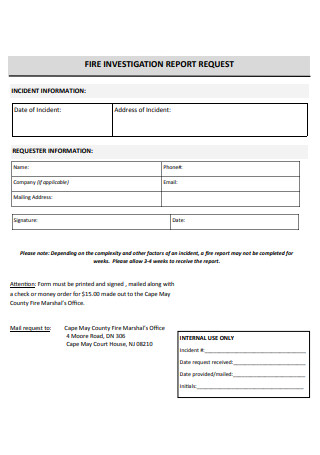
Fire Investigation Report Request
download now -
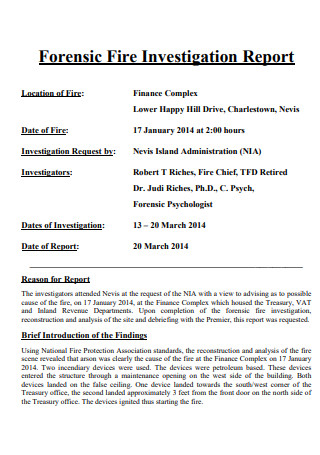
Forensic Fire Investigation Report
download now -
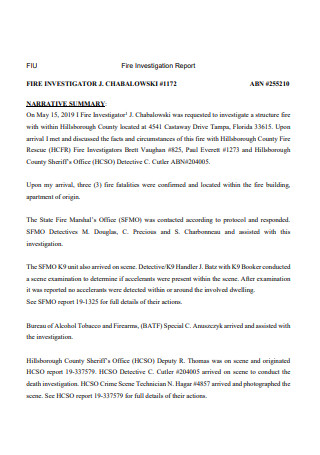
Fire Investigation Report in PDF
download now -
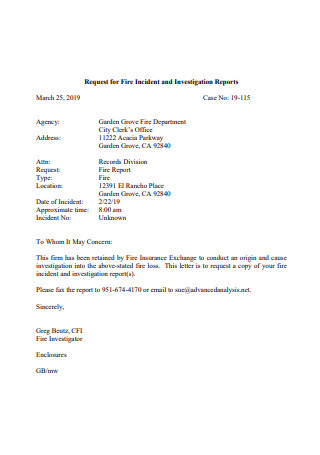
Fire Incident and Investigation Report
download now -
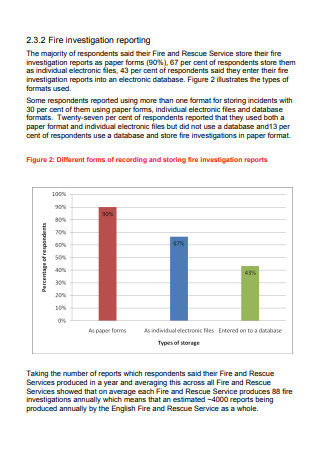
Standard Fire Investigation Reporting
download now -
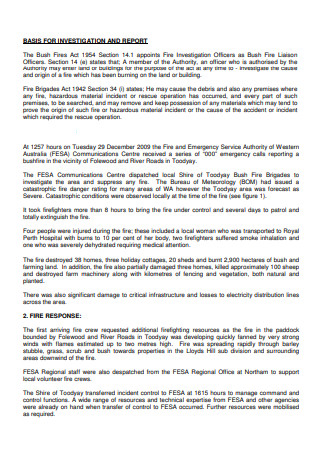
Bush Fire Investigation Report
download now -
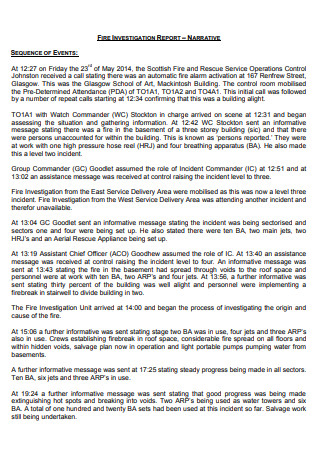
Fire Investigation Report Example
download now -
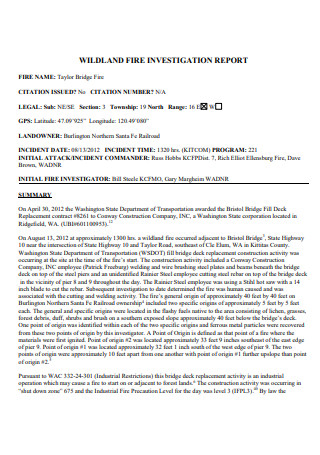
Wildland Fire Investigation Report
download now -

Fire Fighter Investigation Report
download now -
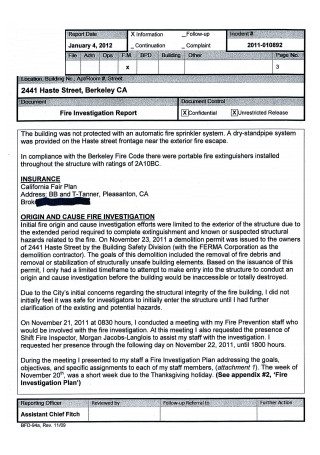
Formal Fire Investigation Report
download now
FREE Fire Investigation Report s to Download
12+ Sample Fire Investigation Report
What is a Fire Investigation Report?
What are the Purposes of a Fire Investigation Report?
How to Conduct a Fire Investigation
Essentials of an Effective Fire Investigation Report
FAQs
How Long Does a Fire Investigation Take?
How do you Write a Fire Investigation Report?
What is a Fire Investigation Report?
While there has been a decline in fire incidents particularly in the city of Zamboanga, Philippines, from 337 (2019) to 183 (2020), 183 is still a large number. This record documentation is made possible with fire investigation reports that in essence, keeps track of fire-related incidents as well as their causes. Below is a lengthier definition of what it is and the purposes it serves. We have also provided a few samples of what it looks like so go ahead and read more to understand it better!
What is a Fire Investigation Report?
A Fire Investigation Report is a comprehensive document that documents and collates all the necessary information, preferably cold hard facts, regarding the fire incident that occurred in order to conjure the most probable sequence of events that lead up to the fire. It may also document if foul play was inflicted or if there is a reason to subject the incident under suspicion except it has to be supported by reliable evidence to be considered worthy of a supplemental investigation.
In most cases with fire incidents, evidence is rarely identified due to its nature of quickly burning everything up so it is important that a competent fire investigator is handling the investigation, one that is still able to properly and thoroughly conduct their methods to the best of their ability regardless of how little there is left for them to work with. Most investigators also branch out, depending on what they determine to be an accomplice to the fire or what they call as accelerants to speed up the spread of the fire, and seek help from forensic scientists or those with expertise on the technology and chemicals present in the scene. You should also take a look at our Research Investigation Report.
An investigation is usually launched once the fire is completely extinguished but fresh and recent enough to obtain information sheet and determine the key evidence or the chain of evidence to construct the cause of the incident.
Moreover, while it is a detailed examination of the location, it also is an assessment of the fire preventive efforts of the place which is why a fire investigation effort does not only gather evidence but identifies the strengths and weaknesses of the prevention program to understand how it can function better in a way that can effectively serve its purpose which is to prevent rapid spread of the fire that causes minimal to no damage at all or completely avoid the occurrence of one in the first place. While the latter is almost impossible, fire investigations still are important tools to identify which parts of the program need modification. In a way, the report functions as a reflection of some sort, however an unfortunate analogy, and provides recommendations for further improvement of existing risk management action plans.
Basically, a fire investigation report is a written report that attempts to determine the origin and the cause of the fire, if it’s accidental, intentional, or brought about by negligence as well as makes out the rest of the circumstances that could have followed that exacerbated the fire. It also functions to pinpoint who could be responsible for accountability to take place but what it really is, is more so to assess the origin of the fire to build up the proper narrative that will explain the situation as accurately as possible. You should also take a look at our work Investigation report.
To summarize what a fire investigation report is in one coherent sentence, it answers the most basic questions about the fire and explains what happened.
What are the Purposes of a Fire Investigation Report?
Well, at this point, the concept of what a fire investigation is should no longer be hard to grasp and now that we feel we have provided a definition that’s fairly easy to digest, that should probably be enough understanding about what a fire investigation report is.
We move on then to its purposes which we understand you probably have a gist of. We’ll confirm whether or not your understanding is right and wrong with the following purposes as to why fire investigation reports are conducted and why they’re important to fire agencies.
It helps assess the fire preventative system.
With fire inherently being a natural occurrence despite it being intentional, there’s nothing much to do to avoid it so most of the built-in fire preventive systems are reactive at best. In a way, it works to assess fire risks and is likewise a risk assessment report. The fire investigations recorded and documented in a comprehensive report serves its purpose by recommending the ways through which efforts of fire suppression and maybe even prevention can be modified. In line with this, it also adds to the plethora of research being done on the topic of fires. Further analysis on the patterns and trends can also be studied to develop more accurate and aggressive safety education programs that draw inspiration from past occurrences with better ways of preventing drastic injuries and worse, fatalities.
It heightens awareness.
With a more developed safety education program, individuals and communities can improve public awareness and work better to mitigate risks in the case of a delayed response.
It’s a preventive measure in and of itself.
To better encapsulate our points into one, fire investigation reports work simultaneously as a preventive measure that encourages better firefighting tactics and more large-scale and prompt operations.
How to Conduct a Fire Investigation
If it wasn’t obvious then, it should be clear now that a fire investigation report involves a systematic process applying an even more meticulous scientific method. However, we won’t exactly delve into the intricacies that involve them but rather mainly discuss the primary steps that everyone interested ought to know of. There are four main steps and they are the following:
Step 1: Arrival at the Fire Scene
Due to the destructive nature of fires, fire investigators, besides preserving the chain of evidence present in the scene and avoiding potential further destruction of evidence, they have to firstly ensure that the workplace they are to surround themselves with is safe enough to conduct a fire investigation. This means having to conduct an inspection beforehand on the areas involved in the fire and checking for all sorts of hazards (ie., respiratory and structural hazards and hazardous substances). Throughout the investigation, the investigators and the team involved shall see to it to follow proper protocols with regards to personal safety and it mainly has to do with gearing oneself with the necessary personal protective equipment. You Should also check out the workplace investigation report.
Another precaution, sometimes forgotten in pursuit of getting work done, is avoiding having to work alone. Regardless of how carefully the fire scene is examined, some little aspects can be overlooked and may be harmful. With someone on your side, this can easily be reported and resolved.
Lastly, the entirety of the location has to be made off-limits to ensure that the area is fully secured from obstruction and contamination of evidence and intrusion of the overall investigation.
Step 2: Investigation of the Fire Scene
This phase in the fire investigation observes and examines the exterior and interior structures, basically the areas where there is clear damage from the fire, to make out a direction of heat flow and eventually determine the point of origin of the fire.
Most investigations are conducted with the assumption that the fire is intentional and is sparked by an arsonist making the area a potential crime scene. With that in mind, the fire investigator has to think similarly as an arsonist committing a literal crime and they will mostly have to need the help of accelerants or chemicals that allow for a more exacerbated spread of the fire. They would have to locate potential containers containing these flammable chemicals or run tests to identify if chemicals are present in the area. You Should also check out the Death Investigation Report.
Basically, the second stage of the investigation is when it actually begins. By examining the structures, fire investigators start narrowing down the origin of the fire. It is important here that the area is properly documented with physical evidence such as photographs while practicing vigilance especially to the presence of electrical appliances and unauthorized technologies.
Step 3: Evidence Documentation
Following the investigation is the gathering of evidence and in a potential crime scene, there could be a lot especially when you start constructing, however vague, a story line of some sort of the incident. It is extremely important that the evidence is properly labelled and provided physical descriptions. All pertinent information, such as observations and the facts thus far, are documented and collated. Keep an evidence log to catalogue them better. You Should also check out the audit investigation report.
In addition to keeping track of the evidence is sketching out the scene and the area where the extent of the damage is evident. It need not be artistically drawn and a candidate for a spot in the Louvre as this is more so intended to produce a graphic representation of the scene for when it is no longer accessible so it is important that the orientations, proportions, distance and dimensions are accurate enough as well as the exact positions of the items of evidence, something photographs are unable to capture.
If a sketch is unfinished because some pieces of evidence are removed like the bodies, they should be marked with chalk or other marking tools, an image we often see in true crime scenes, photographic evidence will make do as a substitute. Along with depicting the accurate locations of the items, the sketch shall also come with the appropriate information such as the name of the person making the sketch, when it is drawn, and basically everything else regarding the fire scene. If the items are not drawn as they are, it is the responsibility of the person making the sketch to provide conventionally used legends (ie., signs, symbols, characters) and their accompanying explanations.
While we did mention that the illustration should be able to accurately depict how the scene looked, the point is still to be consistent with the information as shown in the notes and the photographs gathered.
Step 4: Conclusion of the Investigation
Finally, this is where the fire investigator will best exercise their expertise by piecing everything together and form a coherent conclusion as to what started the fire. This stage of the investigation is further made up of three phases:
Essentials of an Effective Fire Investigation Report
An effective fire investigation report is written with some of these in mind:
1. It is written using the first person.
Fire investigators understand that second or third person is avoided in the writing of the report. Describe the scenes as you would make an entry in a personal diary. More usage of first-person pronouns such as I, me, my, mine, myself, we, us, our, and ourselves and less to none at all of addressing yourself as an outsider with descriptors like ‘the investigator’ or ‘this officer’.
2. It follows proper grammar, spelling and punctuation.
While the point of communication is to be understood regardless of linguistic differences, it is almost essential that fire investigator reports follow basic proper grammar and do not commit improper spelling. If the language of instruction is not your first language, have someone proofread your report before it even reaches your supervisors, the databases and the eventual public consumption. In developing the reports, it is almost crucial to aim for accuracy and it pays to write it with proper stylistics.
In addition to following proper grammar, it is also important to language your report using less terminologies that are unbeknownst to most of your audience and are inclusive amongst fire investigators. If there is a need to use jargon, be sure to explain these terms.
3. It answers to the basic 5 W’s and 1 H’s.
Who?
- Discovered the fire?
- Are the witnesses?
- Is making the report?
- Are the victims?
- Are the potential suspects?
- Put out the fire?
What?
- Was the extent of the damage?
- Is known about the crime?
- What do witnesses know?
- Are the evidence?
- Are the motives of the suspects?
Where?
- Did the fire take place?
- Did the fire start?
- Did the fire travel?
- Were the evidence located?
- Is the evidence inventoried?
When?
- Did the fire occur?
- Was it reported?
- Was the investigation launched?
Why?
- Was the crime committed?
How?
- Did the fire start?
- Did the suspects commit the crime?
4. Avoid including personal opinions, hunches, and intuitions.
Included in the report are only opinions supported by the evidence at hand. As much as possible, the report should be void of personal statements and should be factual at best.
FAQs
How Long Does a Fire Investigation Take?
Depending on a few considerable factors such as the size of the fire, the number of witnesses present, the number of casualties and injuries, the extent of the damage caused on the property or if there are a number of circumstances that warrant heavy suspicion, a fire investigation can take up days up to months and for some major investigations, even years. There’s really no definite way of telling but the team working on the incident definitely are working their best to promptly get to the bottom of the investigation.
How do you Write a Fire Investigation Report?
In writing a fire investigation report, the key points to take into consideration is to provide only the necessary information supported by facts. It shall be written in a way that is objective with conclusions formulated by experts that are reliable enough to not mix in their personal opinions of the incident. Furthermore, we list down a few essentials in writing the report and they are as such:
- It is written using the first person
- It follows proper grammar, spelling and punctuation.
- It answers to the basic 5 W’s and 1 H’s.
- Avoid including personal opinions, hunches, and intuitions.
What is a Fire Investigation Report?
A fire investigation report simply depicts the process of investigating a fire incident and the ways in which it originated before the rightful authorities can take further actions.
